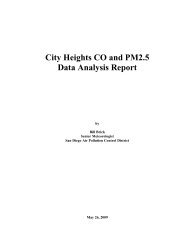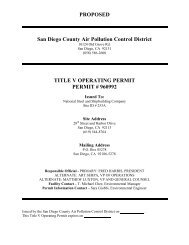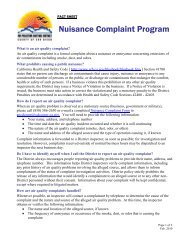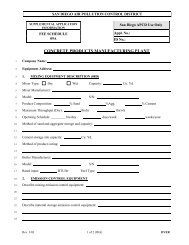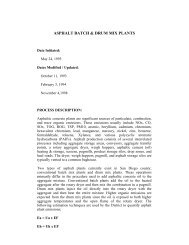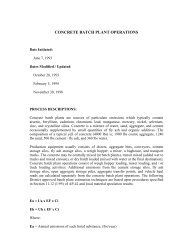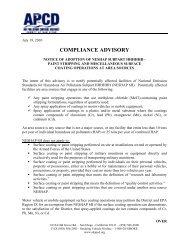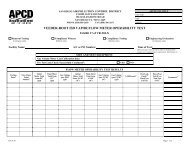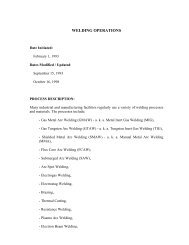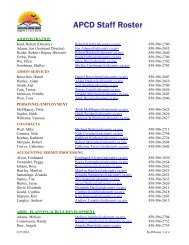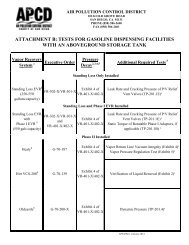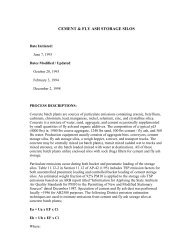Hexavalent Chromium ATCM for Decorative and Hard Chrome
Hexavalent Chromium ATCM for Decorative and Hard Chrome
Hexavalent Chromium ATCM for Decorative and Hard Chrome
Create successful ePaper yourself
Turn your PDF publications into a flip-book with our unique Google optimized e-Paper software.
Effective Date: October 24, 2007(2) Examples of minor changes to a test method include, but are not limited to:(i) Field adjustments in a test method's sampling procedure, such as a modifiedsampling traverse or location to avoid interference from an obstruction in the stack,increasing the sampling time or volume, use of additional impingers <strong>for</strong> a highmoisture situation, accepting particulate emission results <strong>for</strong> a test run that wasconducted with a lower than specified temperature, substitution of a material in thesampling train that has been demonstrated to be more inert <strong>for</strong> the sample matrix;<strong>and</strong> (ii) Changes in recovery <strong>and</strong> analytical techniques such as a change in qualitycontrol/quality assurance requirements needed to adjust <strong>for</strong> analysis of a certainsample matrix.3. Intermediate change to test method means a within-method modification to afederally en<strong>for</strong>ceable test method involving “proven technology'' (generally acceptedby the scientific community as equivalent or better) that is applied on a site-specificbasis <strong>and</strong> that may have the potential to decrease the stringency of the associatedemission limitation or st<strong>and</strong>ard. Though site-specific, an intermediate change may seta national precedent <strong>for</strong> a source category <strong>and</strong> may ultimately result in a revision tothe federally en<strong>for</strong>ceable test method. In order to be approved, an intermediatechange must be validated according to U.S. EPA Method 301 (40 CFR Part 63,Appendix A) to demonstrate that it provides equal or improved accuracy <strong>and</strong>precision. Examples of intermediate changes to a test method include, but are notlimited to: (1) Modifications to a test method's sampling procedure includingsubstitution of sampling equipment that has been demonstrated <strong>for</strong> a particularsample matrix, <strong>and</strong> use of a different impinger absorbing solution; (2) Changes insample recovery procedures <strong>and</strong> analytical techniques, such as changes to sampleholding times <strong>and</strong> use of a different analytical finish with proven capability <strong>for</strong> theanalyte of interest; <strong>and</strong> (3) “Combining'' a federally required method with anotherproven method <strong>for</strong> application to processes emitting multiple pollutants.4. Major change to test method means a modification to a federally en<strong>for</strong>ceable testmethod that uses “unproven technology or procedures'' (not generally accepted bythe scientific community) or is an entirely new method (sometimes necessary whenthe required test method is unsuitable). A major change to a test method may be sitespecific,or may apply to one or more sources or source categories, <strong>and</strong> will almostalways set a national precedent. In order to be approved, a major change must bevalidated according to EPA Method 301 (40 CFR Part 63, Appendix A). Examples ofmajor changes to a test method include, but are not limited to: (1) Use of anunproven analytical finish; (2) Use of a method developed to fill a test method gap;(3) Use of a new test method developed to apply to a control technology notcontemplated in the applicable regulation; <strong>and</strong> (4) Combining two or moresampling/analytical methods (at least one unproven) into one <strong>for</strong> application toprocesses emitting multiple pollutants.5. Minor change to monitoring means: (1) A modification to federally requiredmonitoring that: (i) Does not decrease the stringency of the compliance <strong>and</strong>en<strong>for</strong>cement measures <strong>for</strong> the relevant st<strong>and</strong>ard; (ii) Has no national significance(e.g., does not affect implementation of the applicable regulation <strong>for</strong> other affectedsources, does not set a national precedent, <strong>and</strong> individually does not result in arevision to the monitoring requirements); <strong>and</strong> (iii) Is site-specific, made to reflect oraccommodate the operational characteristics, physical constraints, or safetyconcerns of an affected source. (2) Examples of minor changes to monitoringinclude, but are not limited to: (i) Modifications to a sampling procedure, such as useof an improved sample conditioning system to reduce maintenance requirements; (ii)Increased monitoring frequency; <strong>and</strong> (iii) Modification of the environmental shelter tomoderate temperature fluctuation <strong>and</strong> thus protect the analytical instrumentation.42



